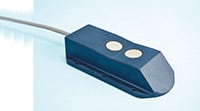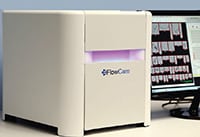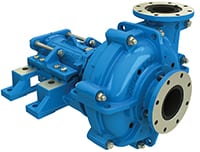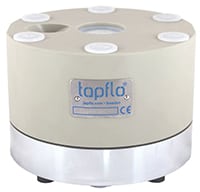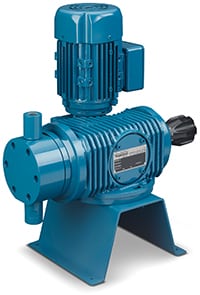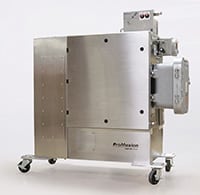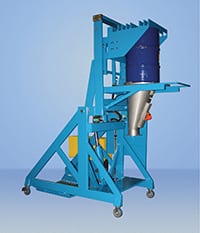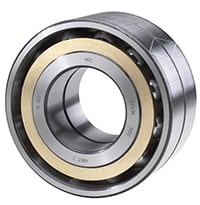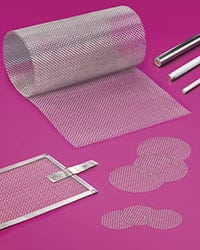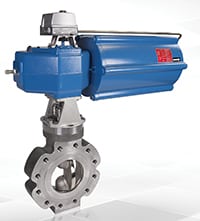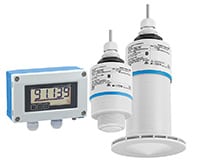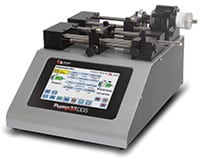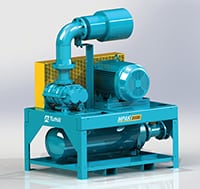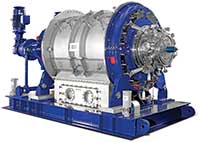New Products & Services
November 2016
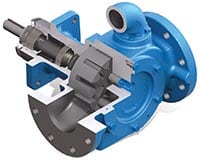 A new and innovative internal gear pump which can be driven by standard electric motors, without the need for a gearbox, is the latest addition to the established range of Viking pumps. The Viking Motor Speed pump (photo), available from this company, is designed to run at higher speeds and deliver increased flows, resulting in a more cost-effective pumping solution requiring less space and at reduced cost. The pumps can be driven by standard electric motors at either 720, 960 or 1,450 rpm, without the need for a reduction gearbox. For many applications, smaller pumps can be run faster, thereby providing higher flows. The range includes models that deliver flowrates up to 88 m³/h at standard motor speeds, or 132 m³/h with speed reducers or gearboxes. Other features include a pump head that incorporates idler and rotor speed grooves to improve axial feed, a liquid directing step to reduce turbulence, a modified crescent to boost radial feed and improved port geometry to optimize flow paths. — Michael Smith
A new and innovative internal gear pump which can be driven by standard electric motors, without the need for a gearbox, is the latest addition to the established range of Viking pumps. The Viking Motor Speed pump (photo), available from this company, is designed to run at higher speeds and deliver increased flows, resulting in a more cost-effective pumping solution requiring less space and at reduced cost. The pumps can be driven by standard electric motors at either 720, 960 or 1,450 rpm, without the need for a reduction gearbox. For many applications, smaller pumps can be run faster, thereby providing higher flows. The range includes models that deliver flowrates up to 88 m³/h at standard motor speeds, or 132 m³/h with speed reducers or gearboxes. Other features include a pump head that incorporates idler and rotor speed grooves to improve axial feed, a liquid directing step to reduce turbulence, a modified crescent to boost radial feed and improved port geometry to optimize flow paths. — Michael Smith
Engineers Ltd., Woking, U.K.
LVTX-10 Series close-range ultrasonic distance and level sensors (photo) are low-profile ultrasonic transmitter modules optimized to provide continuous measurement of fluids, pastes or uneven solid bulk materials in constrained working zones. Incorporating dual-sensor ultrasonic technology and processing algorithms, all LVTX-10 sensors provide accurate measurement for factory automation, warehouse materials control, pipe and conveyor belt blockage, or tank level applications with non-uniform surfaces. LVTX-10 sensors include an advanced diagnostic feature that will retrieve the ultrasonic waveform for analysis, and display it on any computer to aid users with debugging complex installations. For solid materials, surface unevenness is unlikely to affect maximum ranging capability, says the company. An integrated mounting plate with pre-formed holes is provided for easy installation. — Omega Engineering Inc., Stamford, Conn.
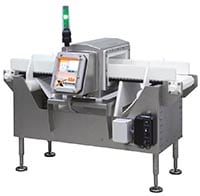 SmartX7Link software gives users the power to remotely monitor, control and download logs for one or more of this company’s Xtreme Metal Detectors (photo). Remote access is available from anywhere within the local network in which the metal detector resides. The technology also enables the manufacturer’s personnel to connect to the metal detector remotely to assist users with set-up and troubleshooting. The Xtreme Metal Detector is a feature-rich, multi-frequency unit designed to achieve the highest levels of sensitivity to detect small ferrous, nonferrous and stainless-steel metal contaminants in packaged, loose and free-fall applications. — Eriez, Erie, Pa.
SmartX7Link software gives users the power to remotely monitor, control and download logs for one or more of this company’s Xtreme Metal Detectors (photo). Remote access is available from anywhere within the local network in which the metal detector resides. The technology also enables the manufacturer’s personnel to connect to the metal detector remotely to assist users with set-up and troubleshooting. The Xtreme Metal Detector is a feature-rich, multi-frequency unit designed to achieve the highest levels of sensitivity to detect small ferrous, nonferrous and stainless-steel metal contaminants in packaged, loose and free-fall applications. — Eriez, Erie, Pa.
The FlowCam 8100 particle imaging and analysis system (photo) features this company’s most advanced camera with the fastest imaging speed and double the image-capture area to increase throughput and detection rates. Imaging at up to 120 frames per second, the FlowCam 8100 automatically detects thousands of individual particles and microorganisms in seconds, takes a high-resolution digital image of each one detected and measures them in realtime based on their actual size and shape. Sampling volumes as small as 200µL, the FlowCam 8100 measures more than 30 different parameters, including particle size, concentration and advanced morphological characteristics such as circularity, elongation and fiber curl. The FlowCam 8100 includes a computer-controlled syringe pump, a quick-connect field of view (FOV) flow cell with holder and an integrated pipette-based sample port with automated rinsing and cleaning. — Fluid Imaging Technologies, Inc., Scarborough, Maine
Launched last month, the Orb Pilot jacketed reactor is said to be a unique system that offers flexible and cost-effective pilot-scale batch chemistry. The Orb Pilot is a user-friendly, floor-standing scale-up jacketed reactor, and offers a choice of vessel sizes from 10 to 50 L on a single system. The reactor can operate at temperatures from –40 to 235°C. Available with a selection of single and vacuum-jacketed vessels, plus a wide range of accessories and stirring options, the Orb Pilot can be easily configured to match user’s requirements. — Syrris Ltd., Royston, U.K.
XHD model pumps are heavy-duty metal- and rubber-lined slurry pumps (photo) that can be serviced while running, due to the presence of more accessible and adjustable parts than comparable slurry pumps, says the manufacturer. These pumps can be installed into existing pump layouts with minimal baseplate and piping changes. The XHD is used in applications such as primary metals, mineral processing, non-metallic mining, power utilities and sand and aggregates. XHD pumps operate with capacities up to 13,000 gal/min, with heads up to 280 ft at temperatures up to 250°F and pressures up to 17 bars. — ITT Goulds Pumps, Seneca Falls, N.Y.
An updated version of this company’s System 800xA Minerals Library (photo) was released last month. The latest version adds functionalities for advanced analog-loop control, further facilitating the engineering processes and widening the scope of visible information to improve situation awareness for operators. With the new loop control connection (LCC), Minerals Library 6.0/0 applies the successful concept of “intelligent objects talking to each other” to the world of loop control. The consistent linking between objects enables engineers to design complex control concepts with a standardized structured approach. The actual control strategy and dependencies between objects are directly visualized on the operator interface. LCC is available for all existing loop-control blocks as well as for the newly added loop-control blocks for actuators, ratio, split-range and adaptive PID (proportional integral derivative) control. These elements deliver powerful functionalities ready to be used on a broad array of advanced control challenges. — ABB, Baden, Switzerland
The new DT series of active pulsation dampeners (photo) is totally redesigned, and has more features and benefits than its predecessor PD. The active pulsation dampener is said to be the most efficient way to remove pressure variations on the discharge of a pump. The dampener works actively with compressed air and a diaphragm, automatically setting the correct pressure to minimize the pulsations. When the liquid pressure falls in the piping system, the dampener supplies extra pressure to the discharge between the pump strokes by displacing liquid by means of diaphragm movement. This pumping action created by the dampener decreases the pressure variations and pulsations. — Tapflo AB, Kungälv, Sweden
The recently introduced Series MP7000 mechanically actuated diaphragm metering pump (photo) was designed to be a low-flow version of this company’s Series MP7100 metering pump. With the ability to dose a wide range of mild to aggressive chemicals, including those used in water and wastewater treatment and chemical processing, the Series MP7000 eliminates the need for intermediate fluid or hydraulic oil to actuate the diaphragm and reduces the potential for gearbox oil to contaminate the process. Series MP7000 pumps also feature the following: a finned gearbox that readily dissipates the heat created during normal operation; oversized check valves that improve performance and minimize friction losses; and rugged bronze gears for quiet running. Additionally, the straight-through flow design of the Series MP7000 liquid end and the elimination of the contour plate result in improved flow characteristics, making the pump suitable for pumping difficult chemicals, such as viscous fluids, shear-sensitive fluids and fluids with suspended solids. Series MP7000 pumps deliver capacities to 27 gal/h and operating pressures up to 16 bars. — Neptune Chemical Pump Co., North Wales, Pa.
The new model PG43SA-D diaphragm pressure gage (photo) features integrated diaphragm monitoring, and thus eliminates the risk of an undetected diaphragm rupture. The patented monitoring functionality enables the immediate indication of any rupture in the diaphragm element via a red warning dot on the dial. Thus, the otherwise usual, regular removal of the instrument to check the measuring element is no longer required. Even in the event of a diaphragm rupture, the process risk is minimized — a second barrier in the pressure-measuring instrument reliably maintains the hermetic separation between the atmosphere and the process. Furthermore, the purely mechanical pressure transmission, which excludes the risk of any contamination through the transmission fluid, and the high overpressure safety enable the PG43SA-D to be used in processes with sensitive or critical media. — WIKA Alexander Wiegand SE & Co. KG, Klingenberg, Germany
The Duo 11 ATEX rotary vane pump (photo), which meets ATEX directive 2014/34/EU, was introduced for processes taking place in potentially explosive atmospheres or conveying explosive gases and vapors. As such, it satisfies the most stringent explosion-protection requirements. The ATEX certification applies for both the interior and exterior of the pump. The Duo 11 ATEX is classified as equipment category 3G and temperature class T4. It can convey all gases up to and including explosion group IIC. The pumping speed is 9 m3/h at 50 Hz and 10.5 m3/h at 60 Hz. The Duo 11 ATEX is equipped with a frictionless magnetic coupling. As a result, the shaft seal rings that are used with other rotary vane pumps can be dispensed with. The extra safety that the magnetic coupling provides is important in explosive atmospheres: without shaft seal rings, it is impossible for media inside the pump to escape out through faulty shaft-seal rings. — Pfeiffer Vacuum GmbH, Asslar, Germany
The Promaxion process mass spectrometer (photo) is said to offer more detailed and relevant data faster than gas chromatography and with more specificity than calorimetry. In field tests, the Promaxion has been used to accurately calculate makeup gas values for complete combustion and monitor and quantify 16 components in a flare-gas stream, including hydrogen, nitrogen, methane, ethane, propane and more. Proprietary software allows for easy setup, operation and calibration, combined with advanced alarm and automation capabilities. The ProMaxion’s modular design and self-diagnostic capabilities ensure ease of maintenance. The instrument is housed in a stainless-steel enclosure. — Ametek Process Instruments, Pittsburgh, Pa.
The hydraulic Lift & Seal System (photo) docks drums to a gasketed pour cone for dust-tight and contaminant-free product discharge. The pour cone features 316-2b stainless-steel construction and a pneumatic turbine vibrator for enhanced product flow. The system’s portable design allows for simple implementation into existing processes. The patented Control Link rotation system safely inverts the drum for maximum product discharge. Units can be custom designed for users’ specific application requirements. — Material Transfer & Storage, Inc. (MTS), Allegan, Mich.
The MRC PumPac series of angular contact ball-bearing arrangements (photo) can reduce operating temperatures and vibration while helping to prevent ball sliding and shuttling in demanding pump applications, including centrifugal pumps and other systems typically subject to significant thrust loads while operating at relatively high speeds. PumPac arrangements incorporate combinations of 40- and 15-deg bearing contact angles capable of carrying high thrust loads within the 40-deg bearing without unloading the opposed 15-deg bearing. As a result, greater axial loads can be applied, and the bearing’s operating temperature and vibration levels will decrease for smoother operation and longer service life, says the company. — SKF USA Inc., Lansdale, Pa.
This company's line of platinum-clad anodes (photo) are metallurgically bonded and are said to be more durable and longer lasting than MMO (mixed metal oxide) counterparts. The anodes are metallurgically bonded platinum to niobium or titanium, with or without a copper core for enhanced conductivity. Featuring a dense, pinhole-free and uniform structure, these anodes provide a more uniform current distribution with lower operating current densities. Designed for electroplating processes, the anodes can be supplied as rod, wire and mesh in a variety of configurations, including precut circles and squares. Woven mesh can be up to 24-in. wide, and wire and rod can range from 0.021- to 1-in. diameter. — Anomet Products, Inc., Shrewsbury, Mass.
The use of 1- and 2-D barcodes and NFC/HF RFID transponders is steadily increasing. They identify items, pallets, containers, storage locations and even yard locations, and therefore help to keep track of asset movements. This company has developed data-capture software, the CamScan Keyboard App (photo), which allows — even offline — barcodes to be scanned and NFC/HF RFID transponders to be read or written using the camera of a smartphone or tablet. The ecom CamScan app is a “keyboard wedge” software utility based on Honeywell’s SwiftDecoder Mobile professional offline barcode decoding software. It uses the integrated camera of the world’s first Zone 1/21 and Division 1 certified tablet, the Tab-Ex 01, and the world’s first intrinsically safe 4G/LTE-capable Android smartphone, the Smart-Ex 01, to scan barcodes, automatically converting them to human readable text. — ecom instruments GmbH, Assamstadt, Germany
The Neles BWX high-performance butterfly valve (photo) has now gained ground in meeting the challenging requirements of various process industries, including applications in air separation units, liquefied natural gas (LNG) and turbines. In addition, BWX valves have been delivered to Siemems’ purified terephthalic acid (PTA) plant in Rotterdam, the Netherlands, for use in the plastic-bottle manufacturing process. The body of the BWX has a monolithic design without a clamp ring, which is optimal for high safety and reliability in use, as there are no additional parts or screws that could detach. The quick-closing butterfly valve has been specifically designed to meet the new oxygen service requirements. The valve has a high C v value provided by its metal-seated butterfly design. As a result of the unique sealing system, the valve can perform even with a critical pressure ratio and at an operating angle as small as 10 deg. — Metso Corp., Helsinki, Finland
The Micropilot FMR10 and FMR20 (photo) free-space radar level transmitters measure liquid levels in storage tanks, open basins, open channels, weirs and canal systems. The FMR10 measures liquid levels at ranges up to 16 ft with 0.2-in. accuracy, while the FMR20 measures levels up to 66 ft. with 0.08-in. accuracy. Both models offer the option of Bluetooth configuration. Protection to IP66/68 and NEMA 4X/6P, hermetically sealed wiring and fully potted electronics eliminate water ingress and allow operation under harsh environmental conditions. Both sensors are available with a flooding tube that allows a maximum output signal to be generated even if an overflow condition causes the sensor to be completely immersed. The level sensors work in process temperatures of –40 to 176°F and pressures of –14 to 43 psi, and are vibration resistant. — Endress+Hauser, Inc., Greenwood, Ind.
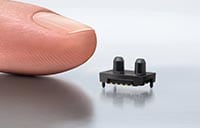 Introduced at electronica 2016 (Munich, Germany; November 8–11), the new SDP3x sensor’s small footprint of just (5 x 8 x 5) mm3 (photo) opens up new dimensions of integration and application possibilities. As with all the company’s differential pressure sensors, the SDP3x features excellent accuracy and longterm stability and has no zero-point drift, says the manufacturer. Furthermore, the SDP3x sensor is reflow solderable and provides extended functionality, such as multiple I2C addresses and interrupts. — Sensirion AG, Staefa, Switzerland
Introduced at electronica 2016 (Munich, Germany; November 8–11), the new SDP3x sensor’s small footprint of just (5 x 8 x 5) mm3 (photo) opens up new dimensions of integration and application possibilities. As with all the company’s differential pressure sensors, the SDP3x features excellent accuracy and longterm stability and has no zero-point drift, says the manufacturer. Furthermore, the SDP3x sensor is reflow solderable and provides extended functionality, such as multiple I2C addresses and interrupts. — Sensirion AG, Staefa, Switzerland
The Pump 33 DDS (dual drive system; photo) is a syringe pump that has two independent pumping channels controlled by an intuitive touchscreen interface. This multipurpose pump employs advanced syringe mechanisms that include a tight-gripping, extremely secure syringe clamp that accommodates syringe sizes ranging from 0.5µL to 60 mL. The Pump 33 DDS offers enhanced flow performance with high accuracy and smooth flow at capacities ranging from 1.02 pL/min to 106 mL/min. — Harvard Apparatus, Holliston, Mass.
Valve solutions must satisfy strict demands when used in complex pure steam systems, such as those in the foodstuff or pharmaceutical industries. The Models 505 and 555 pure-steam valves (photo) are manufactured from high-quality materials, enable optimal processing of the individual materials and offer numerous advantages in terms of both function and servicing. The pneumatic (555) and hand-operated (505) angle-seat globe valves require significantly less maintenance than diaphragm valves, and are easier to clean than ball valves, says the manufacturer. The globe valves are available in nominal sizes DN8 to DN80. Hall 5, Stand F36 — GEMÜ Gebr. Müller Apparatebau GmbH & Co. KG, Ingelfingen, Germany
The new MPAK 2000 blower package (photo) is designed for simple installation and to meet specific applications for optimized efficiencies. Features of the high-endurance MPAK 2000 include air or gas blowers, accurate blower sizing and open or closed package design with field retrofittable enclosure options. The enclosed design features a clear viewing window to check on blower oil levels. Standard gages measure pressure, temperature and filter life. The blower packages provide up to 2,200 ft3 /min flowrate, pressures up to 18 psi and vacuum down to 17 in. Hg. — Tuthill Vacuum & Blower Systems, Burr Ridge, Ill.
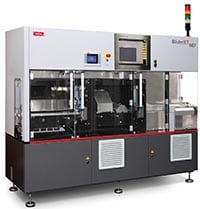 Launched this month at Pack Expo 2016 (Chicago, Ill.; November 6–9), the BlisterJet CMYK (photo) is a UV DOD piezo inkjet printing system for full-color printing on blank blisters in a CMYK application process. The system is said to open up new opportunities in blister-packaging design and product differentiation. Alongside the BlisterJet CMYK, the company exhibited a concept system: Modular, UV DOD, and roll-to-roll, it prints foils in two colors. — Hapa AG, Volketswill, Switzerland
Launched this month at Pack Expo 2016 (Chicago, Ill.; November 6–9), the BlisterJet CMYK (photo) is a UV DOD piezo inkjet printing system for full-color printing on blank blisters in a CMYK application process. The system is said to open up new opportunities in blister-packaging design and product differentiation. Alongside the BlisterJet CMYK, the company exhibited a concept system: Modular, UV DOD, and roll-to-roll, it prints foils in two colors. — Hapa AG, Volketswill, Switzerland
Control Techniques and Leroy-Somer (CT & LS) have launched a new service in Europe designed to increase product availability and delivery speed to its customers. The new Express Availability service means a large range (0.09 up to 500 kW) of motors, servos, geared motors, drives, options and accessories are now available to be shipped directly to users quickly and reliably. The Express Availability program is a strong and reliable commitment to ship products in 1 to 10 working days with an optional express transport in 24 h in Europe in case of emergency. — Emerson Industrial Automation, Control Techniques Ltd., Newtown, U.K.
www.emersonindustrialautomation.com
TEGO Flow 375 and TEGO Flow 460 N are two new flow and leveling additives specifically developed for use in can and coil coatings. Both products are suitable for direct contact with food (FDA 175.300). This reduces complexity for coatings manufacturers and enables broad use. Instead of using many different products, manufacturers can use the same additive for more diverse end-uses. Both products are silicone-free. Impurities and a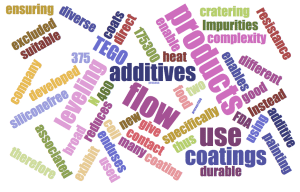 ssociated cratering can therefore be excluded, thus ensuring smooth-running production, says the company. In addition, the flow and leveling additives exhibit improved heat resistance and give the coating a durable, high-quality appearance. Very good adhesion and wetting properties in multi-coat finishes enable both products to be used in all the coats without impairing the painting process. — Evonik Industries AG, Essen, Germany
ssociated cratering can therefore be excluded, thus ensuring smooth-running production, says the company. In addition, the flow and leveling additives exhibit improved heat resistance and give the coating a durable, high-quality appearance. Very good adhesion and wetting properties in multi-coat finishes enable both products to be used in all the coats without impairing the painting process. — Evonik Industries AG, Essen, Germany
The new Proflo USB-IR Adaptor (photo) and Proflo Assist Software provide condition monitoring of reciprocating-compressor lubrication equipment. They read and transfer information from the Proflo PF1 monitoring device, which records the average cycle time for each 30-min block of lubrication-system operation to a laptop, tablet or other USB-equipped device through the use of infrared technology. The Proflo Assist Software presents the cycle-time trend data, delivering condition-based maintenance capabilities. The Proflo PF1 monitors a compressor lubrication system, alerting an operator or engaging shutdown protection based on the cycle time of the system. Realtime access to this information can help technicians intervene and prevent a range of problems, including the extrusion of packing and piston rings, locking of the packing case, valve stiction and more. — Compressor Products International (CPI), Houston
 Released last month, the latest version of Comsol Multiphysics software, version 5.2a, features major performance increases and the Rotordynamics Module, which is now available as an add-on product to the Structural Mechanics Module. The module will aid engineers in analyzing vibrations due to centrifugal forces and other gyroscopic effects in rotating machinery. This new product will be used to ensure that rotor vibrations are contained within acceptable design limits by providing functionality for evaluating critical speed, whirl and bearings. This module will be of particular interest to those working with the design of turbines (photo), turbochargers, electrical machinery and pumps. — Comsol, Inc., Burlington, Mass.
Released last month, the latest version of Comsol Multiphysics software, version 5.2a, features major performance increases and the Rotordynamics Module, which is now available as an add-on product to the Structural Mechanics Module. The module will aid engineers in analyzing vibrations due to centrifugal forces and other gyroscopic effects in rotating machinery. This new product will be used to ensure that rotor vibrations are contained within acceptable design limits by providing functionality for evaluating critical speed, whirl and bearings. This module will be of particular interest to those working with the design of turbines (photo), turbochargers, electrical machinery and pumps. — Comsol, Inc., Burlington, Mass.
Type RPF rotary pressure filters (photo) are continuously operating filters that facilitate gas-tight cake handling in a series of separate process steps. The fully automatic clean-in-place (CIP) system fulfills the stringent requirements of the pharmaceutical and food industries for cleaning surfaces inside of the machine. The filters support a broad range of process steps during a single rotation of the drum. Further processes can be carried out after separating the slurry into filtrate and filter cake, including displacement, countercurrent and closed-cycle washing, as well as reslurrying, solvent exchange, steaming, extraction and mechanical or thermal cake dewatering. All process steps are performed within the filter’s segregated segment zones, making it possible to separately discharge the filtrates or other substances. The rotary pressure filter is a fully encapsulated unit that can be integrated into production processes in a gas-tight manner. This means that it is also suitable for use in operating scenarios with increased safety or hygienic requirements. — BHS-Sonthofen GmbH, Sonthofen, Germany
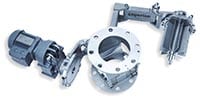 The ZRD sanitary rotary valves (photo) have been approved by the U.S. Dept. of Agriculture (USDA), following certification in compliance with the USDA Dairy Grading Branch. Already designed in accordance with the engineering and design guidelines of the EHEDG (European Hygienic Engineering & Design Group), these sanitary rotary valves also meet the current, strict requirements governing application in the U.S. The valves can be used in the food, pharmaceuticals and chemical industries for applications demanding even the highest degree of hygiene and cleanliness. The ZRD Hygienic Rotary Valve offers an extra-large inlet for high throughputs and is suitable for pneumatic conveying up at up to 1.5 barg and temperatures up to 100°C. The sanitary versions of the ZRD rotary valves are used in pneumatic conveying systems and for the discharge of powdered and granular materials. — Coperion K-Tron, Salina, Kan.
The ZRD sanitary rotary valves (photo) have been approved by the U.S. Dept. of Agriculture (USDA), following certification in compliance with the USDA Dairy Grading Branch. Already designed in accordance with the engineering and design guidelines of the EHEDG (European Hygienic Engineering & Design Group), these sanitary rotary valves also meet the current, strict requirements governing application in the U.S. The valves can be used in the food, pharmaceuticals and chemical industries for applications demanding even the highest degree of hygiene and cleanliness. The ZRD Hygienic Rotary Valve offers an extra-large inlet for high throughputs and is suitable for pneumatic conveying up at up to 1.5 barg and temperatures up to 100°C. The sanitary versions of the ZRD rotary valves are used in pneumatic conveying systems and for the discharge of powdered and granular materials. — Coperion K-Tron, Salina, Kan.
The TiX620 infrared camera’s 640×480 resolution provides measurement accuracy, and its 5.6-in. high-resolution LCD screen enables thermographers to identify issues and edit images directly on the camera while still in the field, reducing time in the office that was previously spent optimizing images and generating reports. The TiX620 provides users with EverSharp multifocal recording, which captures multiple images from different foc al distances and combines them into one image, displaying each object, from foreground to background, sharply for the best image quality. Onboard advanced analytics allow users to adjust or enhance images directly on the camera without additional software. Also included is the company’s SmartView software, which provides a suite of tools to view, optimize, annotate and analyze infrared images, and generate fully customizable professional reports. — Fluke Corp., Everett, Wash.
al distances and combines them into one image, displaying each object, from foreground to background, sharply for the best image quality. Onboard advanced analytics allow users to adjust or enhance images directly on the camera without additional software. Also included is the company’s SmartView software, which provides a suite of tools to view, optimize, annotate and analyze infrared images, and generate fully customizable professional reports. — Fluke Corp., Everett, Wash.
